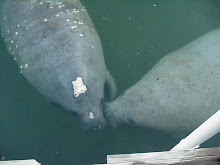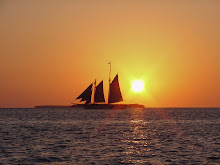These chairs are wooden Adirondacks with little tables to go along with them. Yam and I built the chairs (4) and tables (2) in the family room once they arrived via UPS.
The other day I was looking at two of the chairs and one of the tables. They were tired and worn looking. Five years of the Florida sun and weather had faded them so much that they became the color of an unhealthy liver. They were no longer the nice, deep, red color they once were.
The Colonel suggested I give the pieces of furniture a new coat of paint. We went into the garage and rummaged through the cans of spray paint stored there. I had some pretty colors to choose from...Aqua, Lagoon and Spa Blue.
The day was warm, sunny and breezy at times. I had to time my spraying between zephyrs. I ran out of paint and had to make a run to The Home Depot for more (I also picked up some white, as I will need to give my rockers a new paint job real soon).
I was very pleased with the new, fresh and tropical look of my old table and chairs.
When I was done, my right hand was weak from pressing down on all the spray can nozzles (I wrote Yam a letter that evening and my penmanship, which is suspect to begin with, bore little resemblance to itself...I wonder what Yam will think when she receives my letter).
I had a rainbow of spray paint in my hair, on my arms, face and sunglasses. The wind carried the fine paint mist in my direction each time I failed to time my spraying correctly between breezes (I came clean after a couple of showers and aggressive scrubbing).
I have two more chairs and a table just like these that will need a new paint job soon...time to rummage through the garage again for more leftover spray paint....I think I saw a pretty green in there.








 In 1736, Highland Scots recruited by General James Oglethorpe (remember him from an earlier post?) occupied the fort site. They built temporary thatched huts that served as housing. Later Oglethorpe moved the settlement a short distance upriver to a higher bluff and had a new fort built, Fort Darien.
In 1736, Highland Scots recruited by General James Oglethorpe (remember him from an earlier post?) occupied the fort site. They built temporary thatched huts that served as housing. Later Oglethorpe moved the settlement a short distance upriver to a higher bluff and had a new fort built, Fort Darien. Fort Pulaski's construction began in 1829. It took $1 million, 25 million bricks and 18 years of toil to finish. It was named for Count Casimir Pulaski, the Polish hero of the American Revolution who lost his life in the unsuccessful siege of Savannah in 1779.
Fort Pulaski's construction began in 1829. It took $1 million, 25 million bricks and 18 years of toil to finish. It was named for Count Casimir Pulaski, the Polish hero of the American Revolution who lost his life in the unsuccessful siege of Savannah in 1779.

 In April of 1861, Union troops located on Tybee Island, bombarded Confederate held Fort Pulaski on Cockspur Island with around 5,275 shells. Shells from both Union and Confederate troops passed over the little Cockspur Lighthouse, with never a one hitting it (thank goodness or I would not have been able to get some of those great pictures of the
In April of 1861, Union troops located on Tybee Island, bombarded Confederate held Fort Pulaski on Cockspur Island with around 5,275 shells. Shells from both Union and Confederate troops passed over the little Cockspur Lighthouse, with never a one hitting it (thank goodness or I would not have been able to get some of those great pictures of the 

 The Confederate Army surrendered to the Union Army 30 hours after the bombardment began.
The Confederate Army surrendered to the Union Army 30 hours after the bombardment began. The fort was used by the Union Army as a prison from October 1864 to March 1865. The prisoners endured scurvy, starvation and dysentery. One year after becoming prisoners, 537 men were transferred to Fort Delaware. The remaining 13 prisoners would die at Fort Pulaski, their bodies dehydrated and emaciated. There are some people who claim that the prison area of the fort is still haunted by those Confederate prisoners.
The fort was used by the Union Army as a prison from October 1864 to March 1865. The prisoners endured scurvy, starvation and dysentery. One year after becoming prisoners, 537 men were transferred to Fort Delaware. The remaining 13 prisoners would die at Fort Pulaski, their bodies dehydrated and emaciated. There are some people who claim that the prison area of the fort is still haunted by those Confederate prisoners. It was very interesting to visit both of the forts and to see how fortifications had changed in the years between 1721 and 1829.
It was very interesting to visit both of the forts and to see how fortifications had changed in the years between 1721 and 1829.



































